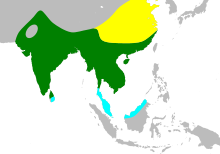Black drongo
| Black drongo | |
|---|---|
 |
|
| Adult in northern India. Note the white rictal spot at the base of the beak. | |
| Scientific classification | |
| Kingdom: | Animalia |
| Phylum: | Chordata |
| Class: | Aves |
| Order: | Passeriformes |
| Family: | Dicruridae |
| Genus: | Dicrurus |
| Species: | D. macrocercus |
| Binomial name | |
|
Dicrurus macrocercus (Vieillot, 1817) |
|
| Subspecies | |
|
D. m. macrocercus (Vieillot, 1817) |
|
 |
|
| Approximate range
Breeding visitor Present year-round Overwintering visitor only |
|
| Synonyms | |
|
Buchanga atra |
|
D. m. macrocercus (Vieillot, 1817)
D. m. albirictus (Hodgson, 1836)
D. m. minor Blyth, 1850
D. m. cathoecus Swinhoe, 1871
D. m. thai Kloss, 1921
D. m. javanus Kloss, 1921
D. m. harterti Baker, 1918
Breeding visitor Present year-round Overwintering visitor only
Buchanga atra
Bhuchanga albirictus
The black drongo (Dicrurus macrocercus) is a small Asian passerine bird of the drongo family Dicruridae. It is a common resident breeder in much of tropical southern Asia from southwest Iran through India and Sri Lanka east to southern China and Indonesia. It is a wholly black bird with a distinctive forked tail and measures 28 cm (11 in) in length. It feeds on insects, and is common in open agricultural areas and light forest throughout its range, perching conspicuously on a bare perch or along power or telephone lines. The species is known for its aggressive behaviour towards much larger birds, such as crows, never hesitating to dive-bomb any bird of prey that invades its territory. This behaviour earns it the informal name of king crow. Smaller birds often nest in the well-guarded vicinity of a nesting black drongo. Previously grouped along with the African fork-tailed drongo (Dicrurus adsimilis), the Asian forms are now treated as a separate species with several distinct populations.
...
Wikipedia

